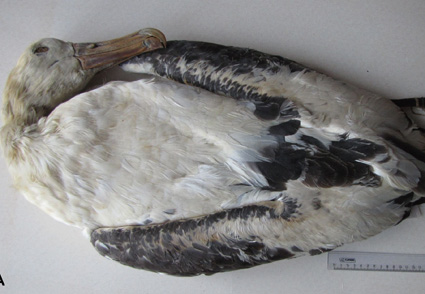Peter Kovalik
Well-known member

Puffinus spp.
Raül Ramos, Vitor H Paiva, Zuzana Zajková, Carine Precheur, Ana Isabel Fagundes, Patrick G R Jodice, William Mackin, Francis Zino, Vincent Bretagnolle, Jacob González-Solís, Spatial ecology of closely related taxa: the case of the little shearwater complex in the North Atlantic Ocean, Zoological Journal of the Linnean Society, , zlaa045, https://doi.org/10.1093/zoolinnean/zlaa045
Abstract:
Seabirds inhabiting vast water masses provide numerous examples where opposing phenomena, such as natal and breeding philopatry vs. vagility have dug cryptic taxonomic boundaries among closely related taxa. The taxonomy of little shearwaters of the North Atlantic Ocean (Little–Audubon’s shearwater complex, Puffinus assimilis–lherminieri) still remains unclear, and complementary information on non-breeding distributions and at-sea behaviour becomes essential to unravel divergent local adaptations to specific habitats. Using miniaturized light-level geolocators from seven study areas in the North Atlantic, we evaluate the spatial and habitat segregation, estimate the timing of their key life-cycle events and describe the at-sea behaviour of three taxa of these little shearwaters year-round to distinguish ecological patterns and specializations that could ultimately unravel potential lineage divergences. We also assess morphometric data from birds that were breeding at each study area to further discuss potential adaptations to specific habitats. Our results show that, while birds from different taxa segregated in space and habitats, they share ecological plasticity, similar annual phenology and diel foraging behaviour. These ecological inconsistencies, while defining the evolutionary stressors faced by these taxa, do not suggest the existence of three Evolutionary Significant Units. However, they confirm the recent evolutionary divergence among the three little shearwaters of the North Atlantic.
Raül Ramos, Vitor H Paiva, Zuzana Zajková, Carine Precheur, Ana Isabel Fagundes, Patrick G R Jodice, William Mackin, Francis Zino, Vincent Bretagnolle, Jacob González-Solís, Spatial ecology of closely related taxa: the case of the little shearwater complex in the North Atlantic Ocean, Zoological Journal of the Linnean Society, , zlaa045, https://doi.org/10.1093/zoolinnean/zlaa045
Abstract:
Seabirds inhabiting vast water masses provide numerous examples where opposing phenomena, such as natal and breeding philopatry vs. vagility have dug cryptic taxonomic boundaries among closely related taxa. The taxonomy of little shearwaters of the North Atlantic Ocean (Little–Audubon’s shearwater complex, Puffinus assimilis–lherminieri) still remains unclear, and complementary information on non-breeding distributions and at-sea behaviour becomes essential to unravel divergent local adaptations to specific habitats. Using miniaturized light-level geolocators from seven study areas in the North Atlantic, we evaluate the spatial and habitat segregation, estimate the timing of their key life-cycle events and describe the at-sea behaviour of three taxa of these little shearwaters year-round to distinguish ecological patterns and specializations that could ultimately unravel potential lineage divergences. We also assess morphometric data from birds that were breeding at each study area to further discuss potential adaptations to specific habitats. Our results show that, while birds from different taxa segregated in space and habitats, they share ecological plasticity, similar annual phenology and diel foraging behaviour. These ecological inconsistencies, while defining the evolutionary stressors faced by these taxa, do not suggest the existence of three Evolutionary Significant Units. However, they confirm the recent evolutionary divergence among the three little shearwaters of the North Atlantic.








